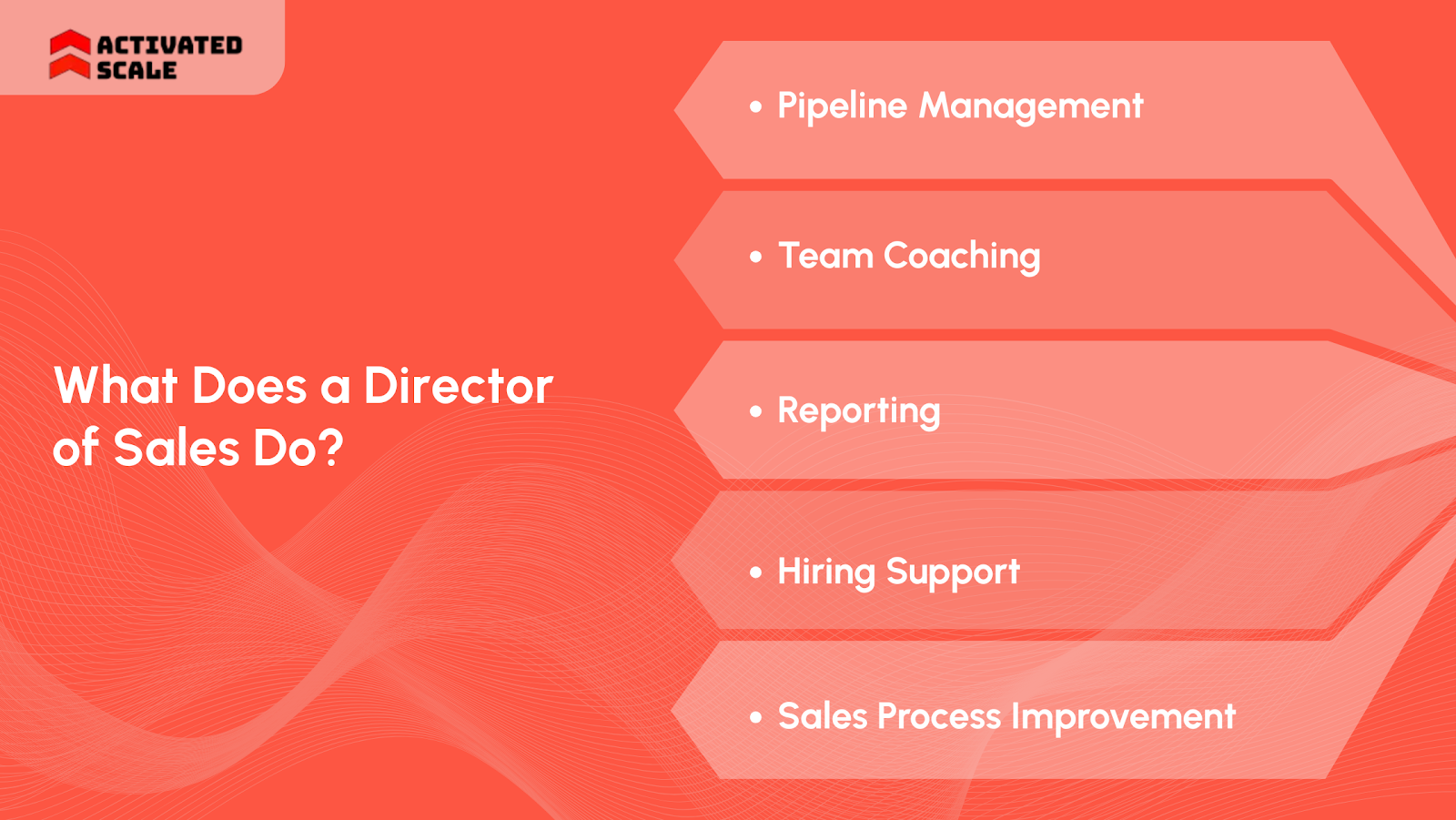Recent data shows that only about 11% of sales organizations achieve meaningful commercial results during a big change. The reason often comes down to how well the sales team is led and structured.
Hiring the right sales leader can change your company’s growth path. However, when hiring a sales leader, it can be confusing to decide whether you need a Director of Sales or a VP of Sales. Both positions are important, but they serve very different goals.
In this guide, you’ll learn how each role works, what their responsibilities look like, and how to decide which one fits your current stage. So, let’s get started.
Key Takeaways
- A Director of Sales manages daily sales execution and team performance, while a VP of Sales defines long-term strategy and structure.
- Hire a Director when you need pipeline consistency and coaching. Hire a VP when you’re ready to scale, expand markets, or build leadership layers.
- Directors focus on near-term goals and quota achievement. VPs focus on company-wide growth, forecasting, and sales planning.
- Small teams of up to five sellers benefit from a Director. Larger teams with multiple layers need a VP to align structure and goals.
- A strong Director can evolve into a VP role once they show strategic leadership and the company grows in size and complexity.
What Does a Director of Sales Do?
A Director of Sales turns strategy into daily execution. They manage sales reps, coach deals, and make sure targets are met each quarter. The role is hands-on and focused on improving performance right now.
Here’s what the position typically involves:
Here are the main responsibilities you can expect from a Director:

- Pipeline Management: Tracks every opportunity, reviews deal stages, and ensures a healthy pipeline ratio.
- Team Coaching: Runs daily or weekly reviews, helping reps refine discovery and closing skills.
- Reporting: Keeps dashboards accurate and shares insights with leadership.
- Hiring Support: Identifies talent needs and provides hiring recommendations based on pipeline data.
- Sales Process Improvement: Refines how deals move from lead to close, creating repeatable steps for growth.
For example, a Director joining a $3 million ARR startup would immediately focus on pipeline discipline and better deal reviews. Within the first quarter, they’d help the team meet quotas more consistently and shorten the average sales cycle.
What Does a VP of Sales Do?
A VP of Sales is responsible for building the structure that supports long-term revenue growth. They set the strategy, design the sales organization, and ensure each region or segment moves in the same direction.
Here’s how their role compares:
Their responsibilities include:

- Strategic Planning: Defines revenue targets, sales coverage models, and headcount needs.
- Forecasting and Analytics: Builds a reliable forecasting process that connects with company goals.
- Team Leadership: Manages Directors or Regional Managers to drive performance through layers.
- Cross-Functional Collaboration: Works with marketing to align messaging and pipeline generation.
- Hiring and Scaling: Plans when to add new roles and builds succession within the team.
For instance, a VP joining a $10 million ARR company would spend the first 30 days reviewing sales data and team design. Within 90 days, they would have a plan to expand coverage, improve forecast reliability, and hire future leaders.
What Is The Difference Between A Director Of Sales And A VP Of Sales?
Choosing between a Director of Sales and a VP of Sales depends on what stage your company is in and what you need from sales leadership right now.
Here’s how the two roles compare:
A Director of Sales focuses on execution. They manage reps, improve win rates, and strengthen the daily rhythm of selling. A VP of Sales focuses on the big picture. They set strategy, design the structure, and prepare the business for the next revenue milestone.
For example, a startup with $2 million ARR that needs stronger pipeline follow-up benefits from hiring a Director. For instance, a company at $8 million ARR stage, planning to expand to new regions, benefits more from a VP who can build the leadership layer and long-term plan.
Not sure which role will be the right fit for you? You can start by testing fractional leadership. Activated Scale connects you with vetted fractional Directors or VPs who can quickly improve performance while you shape your long-term hiring plan.
How To Choose Between a Director of Sales and a VP of Sales?

Choosing between these two roles comes down to your company’s goals, current sales maturity, and growth plans. You want to hire the level of leadership that fits your stage, not the title that sounds senior.
Here are the main questions to consider while making the decision:
- What Is Your Immediate Goal? If you need someone to drive the pipeline and close deals faster, a Director is the right fit. If you want to design a structure that can scale across teams or regions, a VP makes more sense.
- How Mature Is Your Sales Process? If you already have consistent leads and a working process, a Director can strengthen it. If you are still shaping your go-to-market motion and forecast model, a VP can build the foundation.
- What’s Your Team Size? A small team of five or fewer sellers benefits more from a Director who can coach daily. Once you cross 10 or more sellers, a VP helps build a structure that keeps performance predictable.
- How Clear Is Your Target Market? If your ICP and segments are still evolving, a VP helps refine them. If your ICP is stable, a Director ensures the team executes against it.
- How Much Runway Do You Have? If your budget is tight but you need leadership now, consider starting with a fractional leader. You can add full-time roles later once the sales engine proves results.
For example, if your company has a few sellers missing quota because of inconsistent follow-ups, a Director will improve performance quickly. If you’re preparing for expansion into new regions or planning a new product launch, a VP will align teams around the new strategy.
Find Your Perfect Sales Leadership Fit With Activated Scale
Hiring senior sales talent takes time and comes with risk. Many startups spend months searching, only to realize the role was too senior or not senior enough for their stage. With Activated Scale, you can move faster, add proven leadership, and test what your team truly needs before making a long-term hire.
Activated Scale connects startups with vetted U.S.-based fractional and contract-to-hire sales professionals who have sold to similar buyers and ACVs. You can bring in leadership and execution talent within days, not months.
Here’s how Activated Scale helps you build the right structure with less risk:
- Fractional VP of Sales: Get a senior leader who builds your go-to-market plan, refines your sales strategy, and creates a scalable forecast model.
- Fractional Director of Sales: Add a hands-on leader who drives daily execution, improves pipeline discipline, and helps your reps hit quota faster.
- Fractional SDR or BDR: Book qualified meetings with your ideal buyers through targeted outbound and email campaigns.
- Fractional Account Executive: Close full-cycle deals from prospecting and demos to negotiation and close.
- Contract-to-Hire Option: Test performance and culture fit before making a full-time hire.
Sales momentum slows when hiring takes too long. Activated Scale gives you fast access to experienced leaders who already know your market and can start producing results right away.
Don’t lose another quarter to recruiting delays. Book a Call to connect with our team today and build the sales team that fits your company’s growth needs.
FAQs
1. Is a VP of Sales higher than a Director of Sales?
Yes, a VP of Sales leads the overall sales organization and sets strategy, while a Director of Sales manages specific teams or regions and focuses on daily execution.
2. Who should report to a Director of Sales?
Sales Development Representatives (SDRs), Account Executives (AEs), or Regional Sales Managers typically report to a Director of Sales. The Director reports upward to a VP of Sales or directly to the CEO in smaller companies.
3. When should a startup hire a Director of Sales first?
Hire a Director of Sales when your team is small and needs daily coaching, process consistency, and improved deal execution. It’s best for companies with a working sales motion that need stronger performance management.
4. When is the right time to bring in a VP of Sales?
Bring in a VP when your company is ready to scale across new segments, add leadership layers, or align sales with marketing and product strategy. Usually, this happens between $5–10 million ARR.
5. Can a Director of Sales be promoted to VP of Sales later?
Yes, many companies promote from within once the Director has proven they can manage larger teams and plan strategically. The key factor is whether they can think beyond execution and drive a company-wide sales strategy.
The Ultimate Guide to Hiring a Salesperson!
Get the step-by-step guide to hiring, onboarding, and ensuring success!
_edi.png)



